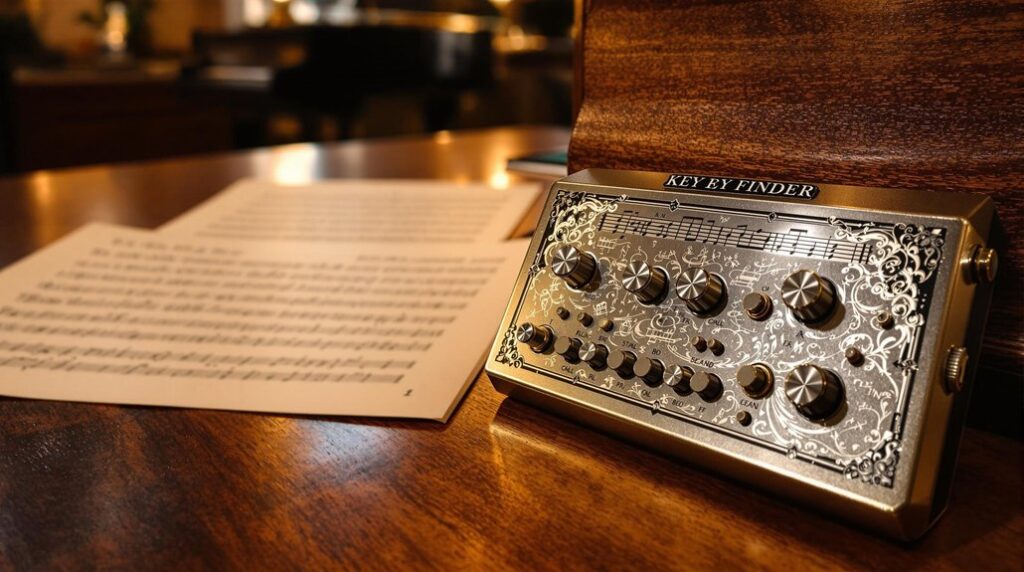The Wheel of Fifths serves as a conceptual framework for organizing musical keys to enhance harmonic mixing. It arranges 12 major and 12 minor keys in a circular format, simplifying changes by highlighting key relationships. The Camelot Wheel further refines this process, assigning Camelot values for seamless integration. With clockwise movement introducing sharps and counterclockwise adding flats, it enhances key compatibility and changes. Further exploration will reveal additional techniques and tools for advanced mixing.
Key Takeaways
- The Wheel of Fifths organizes keys circularly, facilitating harmonic mixing by revealing compatible key relationships.
- Clockwise movement on the Wheel of Fifths adds sharps, boosting musical energy for transitions.
- Counterclockwise movement on the Wheel of Fifths adds flats, decreasing energy and enabling smoother transitions.
- The Camelot Wheel complements the Wheel of Fifths, offering a numeric system for identifying key compatibility.
- Key detection software analyzes tracks for Camelot values, aiding DJs in seamless harmonic mixing.
Understanding the Wheel of Fifths
The Wheel of Fifths is a conceptual tool employed by musicians and DJs to organize and navigate the relationships between musical keys. It arranges all 12 major keys and their corresponding 12 minor keys in a circular format, with each separated by a perfect fifth interval. This organization aids in harmonic mixing by clearly illustrating key relationships. Major keys are denoted in uppercase letters, while minor keys are marked with lowercase "m," indicating their relative minor counterparts. Moving clockwise adds sharps to key signatures, while counterclockwise movement introduces flats, facilitating quick identification. The relative minor key is accessible by descending three semitones from a major key. This configuration supports smooth shifts in DJing by revealing adjacent and harmonically compatible keys. For a more seamless transition between tracks, DJs often employ harmonic mixing techniques to match compatible keys efficiently.
Steering harmonic relationships involves a strategic understanding of the interconnectedness between musical keys, particularly as illustrated through tools like the Circle of Fifths and the Camelot Wheel.
The Circle of Fifths organizes major and minor keys to reveal compatible keys for harmonic mixing. By moving clockwise, DJs can boost energy levels, shifting through keys separated by a perfect fifth. Conversely, counterclockwise movements decrease energy, offering seamless changes to keys a perfect fourth apart.
Each major key's relative minor, descending three semitones, facilitates smooth transfers between major and minor keys.
The Camelot Wheel further simplifies key relationships by labeling them numerically and alphabetically, enabling DJs to identify compatible keys without deep music theory knowledge, enhancing dynamic and cohesive mixes.
Understanding chord progressions aids in creating effective musical builds, allowing DJs to create more engaging and emotionally resonant sets.
The Role of the Camelot Wheel
Within the realm of harmonic mixing, the Camelot Wheel emerges as a pivotal tool, streamlining the process by providing DJs with a straightforward method to navigate key compatibility.
This system assigns a unique Camelot value to each of the 24 Major and Minor keys. Major keys occupy the outer ring, while Minor keys are on the inner ring, enabling DJs to determine compatible keys easily.
By moving one step left or right on the Camelot Wheel, DJs can achieve seamless shifts, effectively controlling energy levels without key clashes.
The tool's design reduces the necessity for extensive music theory knowledge, supported by key detection software, thereby democratizing harmonic mixing for DJs, enhancing the cohesiveness and flow of their musical sets.
Additionally, understanding the Circle of Fifths can complement the use of the Camelot Wheel by providing a visual representation of key relationships, which is crucial for maintaining energy and audience engagement.
Techniques for Harmonic Mixing
Steering through the nuances of harmonic mixing demands a precise understanding of key compatibility, with DJs employing sophisticated techniques to guarantee fluid shifts between tracks.
Harmonic mixing techniques utilize the Camelot Wheel to identify compatible key changes, facilitating seamless shifts when mixing tracks. By selecting adjacent keys, DJs can secure a coherent auditory experience.
Key detection software, such as Mixed In Key, plays an essential role in key analysis, allowing DJs to assign Camelot values for quick identification of harmonically compatible tracks.
To modulate energy levels, DJs strategically move clockwise to raise intensity or counterclockwise for a subdued effect.
Advanced techniques may involve unexpected key changes, such as shifting from 3A to 9A, introducing dynamic shifts that captivate the audience while maintaining musical integrity.
Understanding song structure improves mix cohesion and emotional engagement, allowing DJs to craft seamless and captivating transitions.
Tools for Seamless Transitions
In the field of DJing, tools for seamless changes are critical in achieving a coherent and engaging auditory experience. Key detection software, such as Mixed In Key, enables DJs to analyze their music library, assigning Camelot Wheel values for easy identification of harmonically compatible tracks. This facilitates seamless shifts through harmonic mixing by managing changes between adjacent keys. DJ software like Serato DJ Pro and Traktor Pro enhances this process with features such as Key Sync and waveform analysis, ensuring key compatibility and smoother blends. The Camelot Wheel simplifies key relationships, assisting in quick changes between major and minor keys. Additionally, platforms like DJ.Studio automate playlist organization, optimizing shifts with customizable effects, thereby enhancing the overall flow of DJ sets. With advancements in AI-powered mixing tools, the capability to seamlessly transition between tracks has become even more refined, offering DJs enhanced creative possibilities.
Frequently Asked Questions
What Is the Circle of Fifths Harmonic Mixing?
The Circle of Fifths in harmonic mixing involves circle intervals to explore key relationships, facilitating harmonic progression. Mixing techniques benefit from understanding musical genres, chord substitutions, key modulation, scale degrees, and tonal centers for seamless audio shifts.
How to Use Circle of Fifths for Harmony?
Exploring the Circle of Fifths involves analyzing key relationships, facilitating genre compatibility through chord progressions, scale construction, and modulation techniques. Interval recognition enhances harmonic analysis, while understanding music theory informs performance practices, improving harmonic coherence and shifts.
What Is the Camelot Method?
The Camelot Method utilizes Camelot notation to streamline DJs' workflows by emphasizing key relationships and harmonic compatibility. This enhances mixing techniques, musical shifts, genre blending, performance dynamics, audience engagement, and sound design for cohesive, fluid sets.
Is It Better to Mix by Bpm or Key?
The superiority of BPM variability versus key compatibility in mixing depends on genre blending and desired audience engagement. Tempo matching focuses on song structure and energy levels, while key compatibility enhances harmonic resolution. Shift techniques and mixing styles are essential.
Conclusion
In summary, the Wheel of Fifths serves as an essential tool for understanding and maneuvering harmonic relationships within music. By integrating the Camelot Wheel, musicians can enhance their harmonic mixing techniques, allowing for more seamless shifts between tracks. This methodology not only facilitates a deeper comprehension of musical structures but also optimizes the auditory experience. As technology evolves, new tools and techniques will further refine harmonic mixing, underscoring the enduring importance of theoretical frameworks in practical applications.




